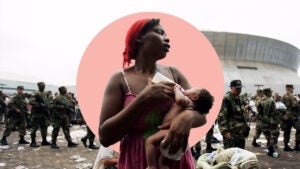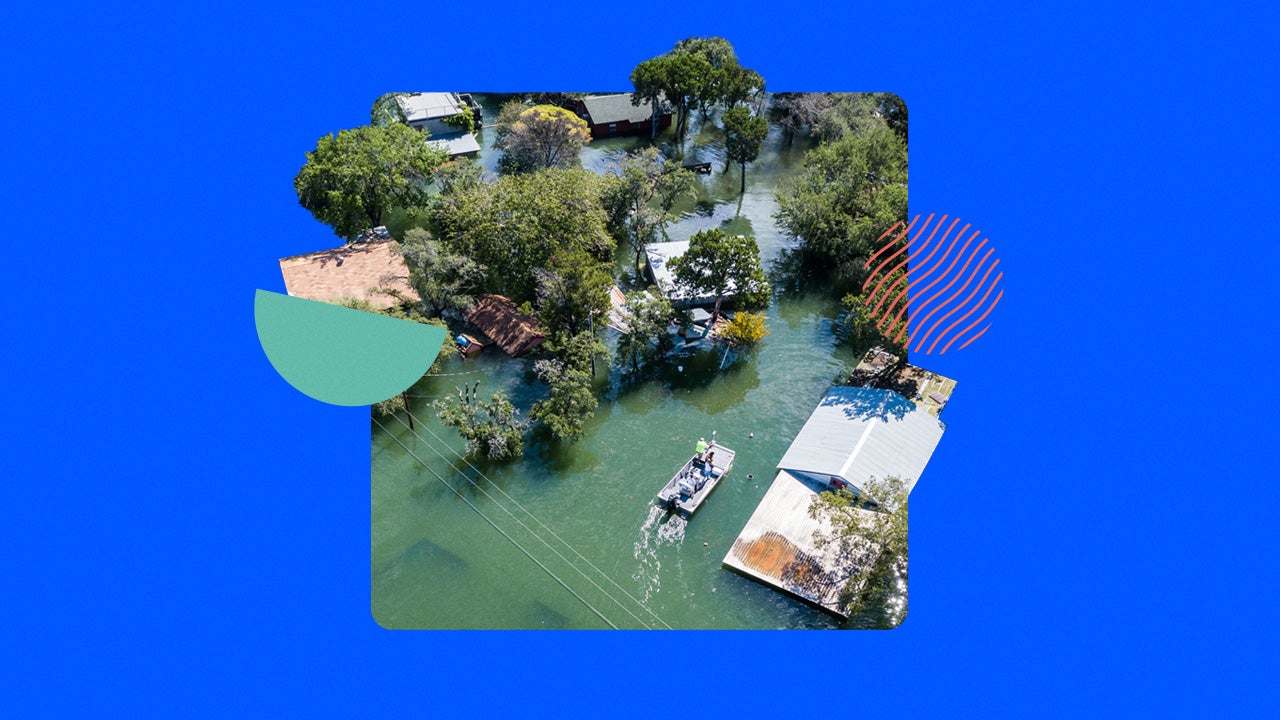Every American is losing money due to extreme weather. Here’s how.

Over the past decade, extreme weather has cost the global economy more than $2 trillion. The United States was hit the hardest, with an estimated $934.7 billion in economic losses from 2014 to 2023. They’re not just numbers in a study — extreme weather events are taking a sizable bite out of Americans’ budgets. Bankrate’s 2024 Extreme Weather Survey found that nearly a quarter (26 percent) of U.S. homeowners say they are unprepared for the potential cost of extreme weather events in their area.
To add salt to the wound, most Americans feel like they have less squirreled away. Bankrate’s Emergency Savings Survey found that almost two-thirds (62 percent) of U.S. adults feel behind on their emergency savings, and only 1 in 5 (20 percent) have more savings now than at the beginning of 2024. Insurance can provide financial help, but you may still need to dip into your own pockets. For instance, you’re on the hook for your policy’s deductible. Beyond paying to repair disasters, extreme weather can impact food prices, energy bills and other everyday expenses.
- 15% of U.S. homeowners say they would be unable to pay their deductibles without going into debt if their home sustained major damage from a severe weather event. (Bankrate Extreme Weather Survey)
- Southern homeowners are more likely to say that they are unable to pay their deductibles without going into debt if their home sustained major damage from a severe weather event compared to Western, Northeastern and Midwestern homeowners. (Bankrate Extreme Weather Survey)
- 17% of U.S. adults had no emergency savings at the beginning of the year, and still have none. (Bankrate Emergency Savings Survey)
What is extreme weather?
Extreme weather is a meteorological term describing a weather event that is rare at a specific place or time of year, including severe or unseasonable weather. The increase in greenhouse gasses released into Earth’s atmosphere since the Industrial Revolution is causing the planet’s temperature to rise, which in turn increases the frequency and intensity of extreme weather events across the globe.
The National Oceanic and Atmospheric Administration (NOAA) tracks climate disasters and their impact on Americans. In the United States alone, there have been over 372 billion-dollar weather and climate-related disasters from 1980 to 2023 that total over $2.7 trillion in damage. These include droughts, floods, freezing temperatures, severe storms, tropical cyclones, wildfires and winter storms.
Hidden costs of extreme weather in housing and transportation
While most homeowners and renters insurance policies cover wind and fire damage, drought and the accompanying extreme heat have Americans paying additional out-of-pocket expenses. The domino-effect of extreme weather also bears costly impacts on other aspects of living that homeowners may not directly anticipate.
Impact for homeowners and renters
A hot summer makes for more than just sweaty armpits. A poll from the Associated Press-NORC Center for Public Affairs found that nearly 7 in 10 Americans report that high heat impacted their electricity bills. Of that group, almost 4 in 10 responded that heat has had a major effect on their monthly electric bills.
Homeowners insurance typically covers damage that is sudden and severe, like a house fire or fallen tree on your roof. Heat and drought rapidly increase wear and tear on your home, but wear and tear is specifically excluded from standard home and renters insurance. Aside from peeling paint, shrinking, and cracking wood siding and fencing, extreme heat can intensify mold and termite issues which impacts a home’s structural integrity and air quality for those who live there.
Droughts also cause soil to shrink, potentially leading your home’s foundation to sink, settle and eventually crack. Uneven floors, cracks in interior and exterior walls and doors and windows that don’t shut properly are signs of foundation damage. Not only are foundation repairs from the effects of drought not covered by home insurance, they can ding the market value of your home.
Flooding is also typically excluded from home and renters insurance. For coverage, you must purchase a separate flood insurance policy or endorsement. Climate change is disrupting precipitation cycles, causing historical rainfall in short periods in some areas. When this happens in locations where the soil is less absorbent from droughts, like Black Rock Desert, Nevada, or where stormwater infrastructure is lacking, like Chicago, the results can be devastating.
Homeowners can take big and small steps to help reduce energy costs in their homes. Installing heat pumps or investing in alternate sources of energy are major changes, but here are some budget-friendly options that you can implement today:
- Keep your thermostat a few degrees lower in the winter and higher in the summer
- Adding weatherstripping to your windows and doors
- Change your air filters regularly to ensure A/C system efficiency
- Turn off lights and appliances when not in use
- Replace light bulbs with energy efficient LEDs
Impact for drivers
Your car insurance should cover sudden damage from extreme weather events as long as you have comprehensive coverage on your car insurance policy. However, if the impacts of extreme weather are not sudden or are not severe enough to warrant filing a claim, you may be out of luck. Extreme heat rapidly degrades tires, windshield wiper blades and paint, all of which cost you money in repairs. Battery and air condition failures are also common during heatwaves. But, like home insurance, an auto insurance policy won’t cover wear and tear.
The cost of car insurance is also on the rise as the frequency and severity of claims increases, so if you live in an area that’s experiencing more extreme weather than in the past, you will likely see your premium go up at renewal.
As climate patterns shift, drivers may see car crashes due to damaged road infrastructure and their ability to maintain control of their vehicles. Dr. Jean-Claude Thill, a geography, public policy and data science fellow of the American Association of Geographers, told Bankrate:
Extreme weather events are most definitely impacting road safety. Whether we are talking about longer and more pronounced snow or ice storms, tornadoes, rain and hail storms, floodings, vehicular mobility is disrupted, and risk of material and human loss is increased by changing the normalcy of conditions expected by drivers.— Dr. Jean-Claude Thill, a geography, public policy and data science fellow of the American Association of Geographers
If your auto insurance costs are on the rise, you might be able to mitigate some of these costs by comparing quotes with other carriers, looking for applicable auto insurance discounts and maintaining a clean driving record to avoid rate surcharges.
Hide from wind, run from water: Evacuation expenses
Extreme weather doesn’t discriminate based on household income. Expectedly, lower-income households are more vulnerable to the impacts of extreme weather. 20 percent of U.S. homeowners earning less than $50,000 per year are very unprepared for the potential costs associated with extreme weather and more than one-third (36 percent) are somewhat prepared — the lowest level of preparedness amongst the household income ranges surveyed.
Evacuation expenses are not covered by home or renters insurance, but depending on the policy and situation, loss of use coverage may pay for your living expenses if your home is uninhabitable while being repaired following a covered loss.
If you live in an area likely to have an evacuation due to extreme weather, you might save money on these expenses by planning ahead. Many travel reward cards offer discounts on rental cars, hotels and even dining, and you may be able to redeem points to pay for your evacuation expenses. If you have to leave your home for covered repairs, keep track of all extra expenses so you have documentation if you choose to submit a loss of use claim.
Unseen ripples: The elusive impact of extreme weather on our daily finances
Our homes and cars are likely some of our biggest investments, but what about our daily spending? A recent report from WTW found that only 25 percent of businesses feel confident that their plans to deal with the impact extreme weather has on their supply chain are sufficient. Shipping disruptions account for some of the increased costs we’re seeing for everyday staples like wheat, canned foods, vegetable oils and petroleum products. With the holidays right around the corner, toys and cell phones will likely cost more and take longer to arrive, along with increases in general shipping costs.
Kate Bulger, the vice president of business development for Money Management International, summarizes how extreme weather can have a ripple effect on our economy:
When a population is impacted by disasters, consumers decrease discretionary spending which affects remaining local businesses. The job market is affected by the reduced spending and the increased number of people trying to find new work. All of this economic pressure makes the entire area less affordable and starts to squeeze out middle income households.— Kate Bulger, VP of business development at Money Management International
Impact of extreme weather on food costs
Extreme weather impacts food availability, quality and affordability. Bankrate data shows that parents of children under 18 are impacted the most — 27 percent of parents experienced food spoilage expenses due to extreme weather in the last decade. Thankfully, many homeowners and renters insurance policies have a provision that offers limited coverage for food spoilage depending on how and where the power outage took place.
Food is the third-largest household expense for Americans, so any loss of food or increase in food cost quickly adds up. According to the Bureau of Labor Statistics, food prices increased by 2.1 percent between October 2023 and October 2024.
Dr. Thill adds, “Chocolate lovers may have noticed the price of their favorite treat has gone up tremendously over the past year. This can be traced to unstable weather conditions resulting in poor cocoa crops in West Africa, where much of the cocoa we consume is grown.”
Shopping seasonally and supporting local farms can help reduce your carbon footprint and support your local community. If you have the space, try creating a hobby farm in your neighborhood where you and your neighbors can swap fruits and vegetables. If you don’t track and budget food expenses, now may be a great time to start. A meticulous budget can help you see where you might be able to save on food costs.
Impact of extreme weather on clothing costs
Bankrate’s Social Media Impulse Purchase Survey found that 48 percent of social media users have made an impulse purchase after seeing a product on social media. Fast fashion retailers thrive on social media sales, but mass-produced pieces need to be replaced often and are made in facilities with poor working conditions and heavy pollutant production.
According to The World Bank, the fashion industry is responsible for 10 percent of annual global carbon emissions and annually uses 93 trillion liters of water. To put that into perspective, it takes 3,781 liters of water to produce one pair of jeans.
This puts budget minded consumers in a quandary — is saving money on cheap clothing today worth the future cost? Unfortunately, extreme weather is driving up the cost of clothing, making it more difficult for many consumers to invest in a sustainable wardrobe. Ethical fashion choices tend to cost much more than standard clothing.
Thrifting is an economical and sustainable way to purchase unique clothes and furniture without paying full price. Learning how to repair small holes and rips can also help extend the life of your clothing. Choosing to wait a day or two before making a purchase can also help you avoid impulse buys.
Learn more
- Guide to energy efficient homes
- How to save on homeowners insurance
- How to do holiday shopping on a budget
Methodology
Bankrate commissioned YouGov Plc to conduct the survey. All figures, unless otherwise stated, are from YouGov Plc.
Extreme Weather Survey: The total sample size was 2,374 U.S. adults, of whom 1,293 are homeowners. Fieldwork was undertaken between July 29–31, 2024.
Emergency Savings Survey: Total sample size was 2,511 U.S. adults. Fieldwork was undertaken between Sept. 18–20, 2024.
Social Media Impulse Purchase Survey: Total sample size was 3,607 U.S. adults, of which 3,304 are members of at least one social media platform. Fieldwork was undertaken between August 16-20, 2023.
The survey was carried out online and meets rigorous quality standards. It employed a non-probability-based sample using both quotas upfront during collection and then a weighting scheme on the back end designed and proven to provide nationally representative results.
You may also like

Shouldering the burden: The unequal impact of extreme weather on women

Extreme weather’s financial effect on homeownership

Extreme weather’s financial burden on the U.S. South



